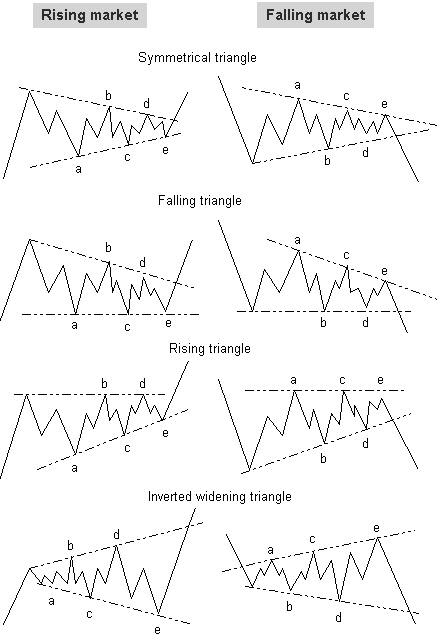Latest News
2022 Start working on a new website
BBS Trading Expert
Watch the Youtube BBS video and here is a crude oil trading example
Want to know more about:
AXIOM business books awards, bronze medal! Thank You!
No longer available!
Favorite articles in 2010, 11, 12, 14 and 2015 S&C Readers' Choice Awards.
AXIOM Business Books Awards, bronze medal.
Technical Analysis Elliott Waves Part 6
Triangles
A triangle correction pattern has the form of a triangle.
Special offer: "Capturing Profit with technical Analysis"

Figure 7.24: Different types of triangle correction patterns.
Figure 7.24 shows the different types of triangle correction patterns.
The triangle is a correction pattern consisting of five waves identified with the letters ABCDE. The triangle is drawn between the points AC and BD. It can be a symmetrical triangle or a rising or falling triangle. An inverted widening triangle is a rather rare.
Triangles will not be found in any type 2 wave, in a flat correction B wave, or in double or triple flat correction waves W, X, and X².
The inverted widening triangle is never seen in double or triple zigzag waves X or X².
All waves within a triangle pattern are correction waves.
Wave E will, in some cases, penetrate the AC line.
In the normal triangles we note three types: symmetrical, rising, or falling triangles.
The inverted widening triangle only exists in a symmetrical version.
Rules and Guidelines for the Triangle
- Wave A is a simple, double, or triple zigzag pattern, or a flat correction.
- Wave B is a simple, double, or triple zigzag pattern.
- Waves C and D can be any correction pattern, except a triangle.
- Waves ABC and D remain within or close to the triangle channel.
- The triangle is closed after wave E.
- The triangle lines converge; they cannot be parallel lines.
- One of the sides of the triangle can be a horizontal line.
- Wave E is a simple, double, or triple zigzag pattern, or a triangle.
- Wave E has a smaller price move than wave D, but it moves more than 20% of D.
- Either wave A or wave B has the biggest price move.
- Wave E ends in the range of wave A.
- Wave E ends within or close to the BD line.
Rules and Guidelines for the Inverted Widening Triangle
- The five waves have a simple, double, or triple zigzag pattern.
- Wave B is smaller than wave C, but a minimum 40% of wave C
- Waves ABCD move within or close to the lines AC and BD.
- Wave C is smaller than wave D, but a minimum 40% of wave D.
- Wave A moves within the line AC.
- Wave A starts after the starting point of the inverted triangle.
- The channel lines of the inverted triangle diverge; they cannot be parallel lines.
- None of the channel lines can move horizontally.
- Wave E is bigger than wave D, but wave D is a minimum 40% of wave E.
- Either wave A or wave B has the smallest price move.
- Wave E ends in the range of wave A.
- Wave E ends within or close to the BD line.
Elliott Waves Next -Previous -Part 1 -Part 2 -Part 3 -Part 4 -Part 5 -Part 6 -Part 7
STOCATA Stocks Technical Analysis HOME
Links
Find a Stock ticker symbol, enter the ticker and find a chart, news, fundamentals and historical quotes.
Risk Disclosure: Futures and forex trading contains substantial risk and is not for every investor. An investor could potentially lose all or more than the initial investment. Risk capital is money that can be lost without jeopardizing ones’ financial security or life style. Only risk capital should be used for trading and only those with sufficient risk capital should consider trading. Past performance is not necessarily indicative of future results.
Hypothetical Performance Disclosure: Hypothetical performance results have many inherent limitations, some of which are described below. no representation is being made that any account will or is likely to achieve profits or losses similar to those shown; in fact, there are frequently sharp differences between hypothetical performance results and the actual results subsequently achieved by any particular trading program. One of the limitations of hypothetical performance results is that they are generally prepared with the benefit of hindsight. In addition, hypothetical trading does not involve financial risk, and no hypothetical trading record can completely account for the impact of financial risk of actual trading. for example, the ability to withstand losses or to adhere to a particular trading program in spite of trading losses are material points which can also adversely affect actual trading results. There are numerous other factors related to the markets in general or to the implementation of any specific trading program which cannot be fully accounted for in the preparation of hypothetical performance results and all which can adversely affect trading results.
See more 'Legal Disclosures' in the bottom menu bar!


